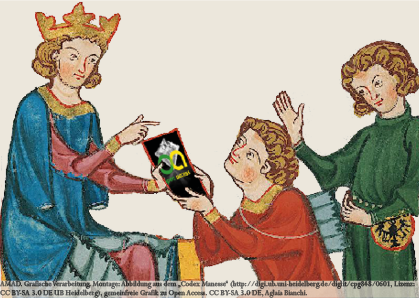AMAD
"Archivum Medii Aevi Digitale - Specialized open access repository for research in the middle ages"To submission

| Date: | 2015 |
| Title: | Arabic Pseudo-Script And The Italian Renaissance |
| Author: | Al-Tawil, Wihad |
| Description: | ABSTRACT ARABIC PSEUDO-SCRIPT AND THE ITALIAN RENAISSANCE by WIHAD AL-TAWIL May 2015 Advisor: Dr. Jennifer Olmsted Major: Art History Degree: Master of Arts The curious pseudo-Arabic script found on artworks of the Italian Renaissance period provide art historians with an interesting challenge. Through the teachings of western-based perspectives of history, it has come to be accepted that pseudo-Arabic was included in religious artworks chiefly as a visual tool which referenced the eastern roots of Christianity. This essay proposes an alternative model of interpretation, however, which explains the inclusion of pseudo-Arabic script as a visual indication of humanism—an educational mentality born and cultivated during the Islamic golden age. The Italian Renaissance propagated a humanist ideology rooted in the study of Greek philosophy, among other things. In fact, humanism was a central tenet of the Renaissance and pertinent to the understanding of the art produced during the period. Prior to the Renaissance, however, was the Islamic golden age—an 800-year period of scholastic achievement in all areas of academic inquiry. Above all, the Islamic golden age birthed the field of humanism up to 600 years prior to the Italian Renaissance, effectively nurturing a philosophic, scientific and cultural standard inspired by ancient Greek texts which were translated into Arabic. This essay proposes that the intermediary Islamic civilization of the 8th-12th centuries—represented by Arabic language and script and marked by the cultivation of humanism—was met with great reverence by the Renaissance Italian world. Furthermore, the inclusion of pseudo-Arabic script acted as a conscious recognition of the humanist Islamic world, therefore aligning the Italian Renaissance with the same humanist ideals which prevailed Islam and made their way to Europe through the rigorous translation of texts. |
| URI: | https://www.amad.org/jspui/handle/123456789/58625 |
| Other Identifier: | https://digitalcommons.wayne.edu/oa_theses/430 https://digitalcommons.wayne.edu/cgi/viewcontent.cgi?article=1487&context=oa_theses |
| AMAD ID: | 701076 |
| Appears in Collections: | BASE (Bielefeld Academic Search Engine) General history of Europe |

